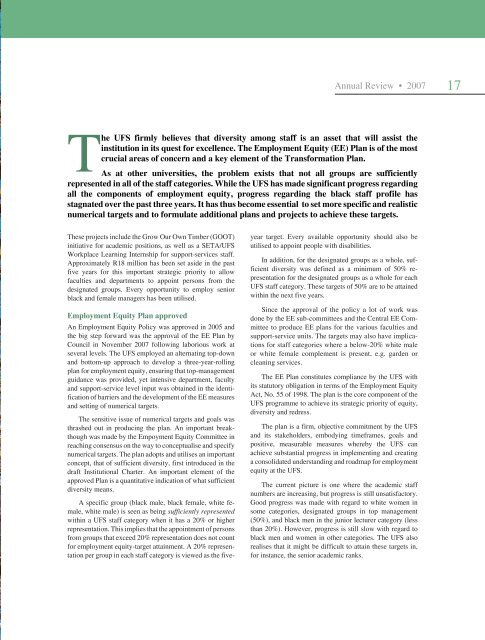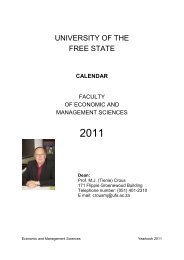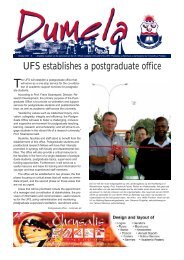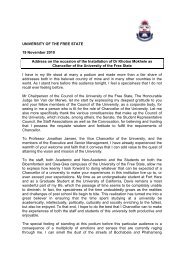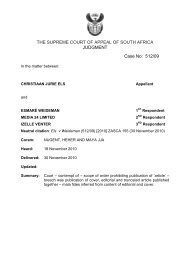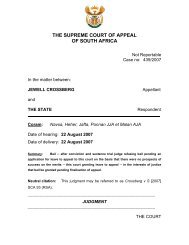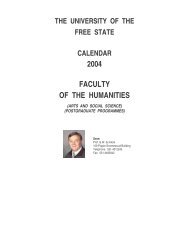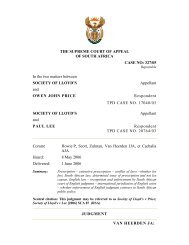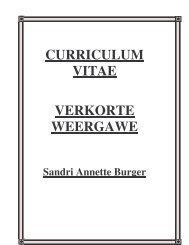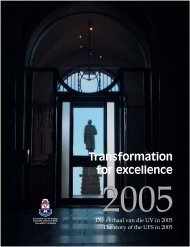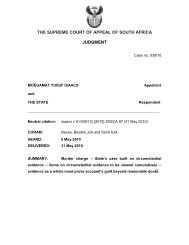UV Jaaroorsig - University of the Free State
UV Jaaroorsig - University of the Free State
UV Jaaroorsig - University of the Free State
Create successful ePaper yourself
Turn your PDF publications into a flip-book with our unique Google optimized e-Paper software.
These projects include <strong>the</strong> Grow Our Own Timber (GOOT)<br />
initiative for academic positions, as well as a SETA/UFS<br />
Workplace Learning Internship for support-services staff.<br />
Approximately R18 million has been set aside in <strong>the</strong> past<br />
five years for this important strategic priority to allow<br />
faculties and departments to appoint persons from <strong>the</strong><br />
designated groups. Every opportunity to employ senior<br />
black and female managers has been utilised.<br />
Employment Equity Plan approved<br />
An Employment Equity Policy was approved in 2005 and<br />
<strong>the</strong> big step forward was <strong>the</strong> approval <strong>of</strong> <strong>the</strong> EE Plan by<br />
Council in November 2007 following laborious work at<br />
several levels. The UFS employed an alternating top-down<br />
and bottom-up approach to develop a three-year-rolling<br />
plan for employment equity, ensuring that top-manage ment<br />
guidance was provided, yet intensive department, faculty<br />
and sup port-service level input was obtained in <strong>the</strong> identification<br />
<strong>of</strong> barriers and <strong>the</strong> development <strong>of</strong> <strong>the</strong> EE measures<br />
and set ting <strong>of</strong> numerical targets.<br />
The sensitive issue <strong>of</strong> numerical targets and goals was<br />
thrashed out in producing <strong>the</strong> plan. An important breakthough<br />
was made by <strong>the</strong> Empoyment Equity Committee in<br />
reaching consensus on <strong>the</strong> way to conceptualise and specify<br />
numerical targets. The plan adopts and utilises an important<br />
concept, that <strong>of</strong> sufficient diversity, first introduced in <strong>the</strong><br />
draft Institutional Charter. An important element <strong>of</strong> <strong>the</strong><br />
approved Plan is a quantitative indication <strong>of</strong> what sufficient<br />
diversity means.<br />
A specific group (black male, black female, white female,<br />
white male) is seen as being sufficiently represented<br />
with in a UFS staff category when it has a 20% or higher<br />
representation. This implies that <strong>the</strong> appointment <strong>of</strong> persons<br />
from groups that exceed 20% representation does not count<br />
for employment equity-target attainment. A 20% re pre sentation<br />
per group in each staff category is viewed as <strong>the</strong> five-<br />
Annual Review • 2007 17<br />
The UFS firmly believes that diversity among staff is an asset that will assist <strong>the</strong><br />
institution in its quest for excellence. The Employment Equity (EE) Plan is <strong>of</strong> <strong>the</strong> most<br />
crucial areas <strong>of</strong> concern and a key element <strong>of</strong> <strong>the</strong> Transformation Plan.<br />
As at o<strong>the</strong>r universities, <strong>the</strong> problem exists that not all groups are sufficiently<br />
represented in all <strong>of</strong> <strong>the</strong> staff categories. While <strong>the</strong> UFS has made significant progress regarding<br />
all <strong>the</strong> components <strong>of</strong> employment equity, progress regarding <strong>the</strong> black staff pr<strong>of</strong>ile has<br />
stagnated over <strong>the</strong> past three years. It has thus become essential to set more specific and realistic<br />
numerical targets and to formulate additional plans and projects to achieve <strong>the</strong>se targets.<br />
year target. Every available opportunity should also be<br />
utilised to appoint people with disabilities.<br />
In addition, for <strong>the</strong> designated groups as a whole, sufficient<br />
diversity was defined as a minimum <strong>of</strong> 50% representation<br />
for <strong>the</strong> designated groups as a whole for each<br />
UFS staff category. These targets <strong>of</strong> 50% are to be attained<br />
within <strong>the</strong> next five years.<br />
Since <strong>the</strong> approval <strong>of</strong> <strong>the</strong> policy a lot <strong>of</strong> work was<br />
done by <strong>the</strong> EE sub-committees and <strong>the</strong> Central EE Committee<br />
to produce EE plans for <strong>the</strong> various faculties and<br />
sup port-service units. The targets may also have implications<br />
for staff categories where a below-20% white male<br />
or white female complement is present, e.g. garden or<br />
cleaning services.<br />
The EE Plan constitutes compliance by <strong>the</strong> UFS with<br />
its statutory obligation in terms <strong>of</strong> <strong>the</strong> Employment Equity<br />
Act, No. 55 <strong>of</strong> 1998. The plan is <strong>the</strong> core component <strong>of</strong> <strong>the</strong><br />
UFS programme to achieve its strategic priority <strong>of</strong> equity,<br />
diversity and redress.<br />
The plan is a firm, objective commitment by <strong>the</strong> UFS<br />
and its stakeholders, embodying timeframes, goals and<br />
positive, measurable measures whereby <strong>the</strong> UFS can<br />
achieve substantial progress in implementing and creating<br />
a consolidated understanding and roadmap for employment<br />
equity at <strong>the</strong> UFS.<br />
The current picture is one where <strong>the</strong> academic staff<br />
numbers are increasing, but progress is still unsatisfactory.<br />
Good progress was made with regard to white women in<br />
some categories, designated groups in top management<br />
(50%), and black men in <strong>the</strong> junior lecturer category (less<br />
than 20%). However, progress is still slow with regard to<br />
black men and women in o<strong>the</strong>r categories. The UFS also<br />
realises that it might be difficult to attain <strong>the</strong>se targets in,<br />
for instance, <strong>the</strong> senior academic ranks.


